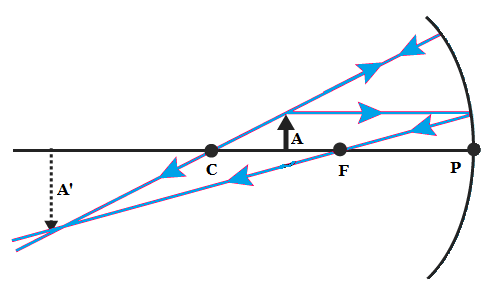
A person is looking at the image of his face in a mirror by holding it close to his face. The image formed is virtual. When he moves the mirror away from his face, the image is inverted. What type of mirror is he using?
(A) Plane mirror
(B) Concave mirror
(C) Convex mirror
(D) Combination of mirror and lenses
Answer
219.6k+ views
Hint: It is given that the image changes from an erect virtual image formed behind the mirror to a real inverted image formed in front of the mirror. Thus we need to find a mirror which can produce both real and virtual images. Only a concave mirror can produce such kinds of images.
Complete step by step solution:
We will analyze how an image formed in a concave mirror changes as the object is moved from infinity to the pole of the mirror.
Initially, when the object is at an infinite distance from the pole of the mirror, the image is formed at the focus. This image is real and is concentrated at a single point.
As we move the object closer to the mirror, the image also starts becoming larger. This image is an inverted real image and is smaller than the object.
When the object reaches the centre of curvature of the mirror, the real image formed is exactly below the object, inverted and of the same size as that of the object.
As the object moves from the centre of curvature of the mirror to the focus, the image size increases. At the focus, the real, inverted image formed is at infinity and is much larger than the object. In the question above, the second case is of this category.

When the person moves his face away from the mirror, the image changes from an erect virtual image to a real inverted magnified image formed in front of the mirror as shown in the above figure.
Now as the object is moved further closer to the mirror, the image becomes virtual and forms on the other side of the mirror. This virtual image is erect and magnified. In the question, the image formed in the first case when the person has his face near to the mirror is this kind of an image.
Thus the correct answer is option (B) Concave mirror.
Note: We can eliminate the plane mirror as it does not form an inverted image. Also, convex mirrors are such that they form only virtual images. Their images are erect, on the other side of the mirror and diminished in size. Now considering a concave mirror, we see that it has similar image formation characteristics as stated in the question.
Complete step by step solution:
We will analyze how an image formed in a concave mirror changes as the object is moved from infinity to the pole of the mirror.
Initially, when the object is at an infinite distance from the pole of the mirror, the image is formed at the focus. This image is real and is concentrated at a single point.
As we move the object closer to the mirror, the image also starts becoming larger. This image is an inverted real image and is smaller than the object.
When the object reaches the centre of curvature of the mirror, the real image formed is exactly below the object, inverted and of the same size as that of the object.
As the object moves from the centre of curvature of the mirror to the focus, the image size increases. At the focus, the real, inverted image formed is at infinity and is much larger than the object. In the question above, the second case is of this category.

When the person moves his face away from the mirror, the image changes from an erect virtual image to a real inverted magnified image formed in front of the mirror as shown in the above figure.
Now as the object is moved further closer to the mirror, the image becomes virtual and forms on the other side of the mirror. This virtual image is erect and magnified. In the question, the image formed in the first case when the person has his face near to the mirror is this kind of an image.
Thus the correct answer is option (B) Concave mirror.
Note: We can eliminate the plane mirror as it does not form an inverted image. Also, convex mirrors are such that they form only virtual images. Their images are erect, on the other side of the mirror and diminished in size. Now considering a concave mirror, we see that it has similar image formation characteristics as stated in the question.
Recently Updated Pages
Electricity and Magnetism Explained: Key Concepts & Applications

JEE Energetics Important Concepts and Tips for Exam Preparation

JEE Isolation, Preparation and Properties of Non-metals Important Concepts and Tips for Exam Preparation

JEE Main 2021 July 25 Shift 1 Question Paper with Answer Key

JEE Main 2021 July 22 Shift 2 Question Paper with Answer Key

States of Matter Chapter For JEE Main Chemistry

Trending doubts
JEE Main 2026: Application Form Open, Exam Dates, Syllabus, Eligibility & Question Papers

Understanding Uniform Acceleration in Physics

Derivation of Equation of Trajectory Explained for Students

Hybridisation in Chemistry – Concept, Types & Applications

Understanding the Angle of Deviation in a Prism

Understanding Atomic Structure for Beginners

Other Pages
JEE Advanced Marks vs Ranks 2025: Understanding Category-wise Qualifying Marks and Previous Year Cut-offs

Dual Nature of Radiation and Matter Class 12 Physics Chapter 11 CBSE Notes - 2025-26

How to Convert a Galvanometer into an Ammeter or Voltmeter

Understanding Centrifugal Force in Physics

JEE Main Marking Scheme 2026- Paper-Wise Marks Distribution and Negative Marking Details

Degree of Dissociation: Meaning, Formula, Calculation & Uses




